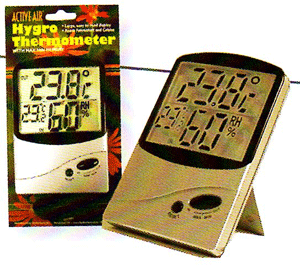

Orchid Care - Humidity |
||||||
The tropical creatures that they are, orchids grow best with at least 40% humidity. If you live in a cold climate and your home has central heating, maintaning 40% humidity levels can be a challenge in the winter. The problem is your furnace. As it heats the air, it's also baking out the moisture. Growing healthy orchids in dry air is nearly impossible. If your humidity levels are less than 30%, you're going to have to make some improvements. I'll show you 5 ways to increase the humidity in your growing area below. Both you and your orchids will be more comfortable during the winter winter with higher humidity levels in your home. |
 Many orchids are comfortable with the same temperatures we live in. Humidity is another matter however. |
|||||
|
||||||
Orchids need humidity! Humidity (moisture in the air) is a vital ingredient in growing healthy orchids. 40-70% relative humidity is ideal. To keep room temperatures comfortable in winter, central heating systems push out hot, dry air hour after hour. Maintaining 40% humidity under these conditions is impossible without help. Many homes in cold climates have humidity levels as low as 10-20% during winter months! |
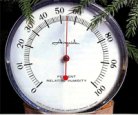 |
|||||
| Low humidity makes
life difficult for orchids.
(10-20% humdity levels are normally found in the
desert!) Warning: Don't confuse humidity (moisture in the air) with water in the pot. Watering your plants more to compensate for dry air is another sure way to kill your orchids. On the other hand, plants tend to dry out faster when exposed to dry air. So some of your plants might require more water when humidity levels are low. With hydroponics this is easy because the water gauge tells you when to water - you don't have to guess. |
||||||
5 Ways to Increase Humidity (Moisture in the Air) |
||||||
| 1. Misting Plants Misting is great for people who think they always "need to do something" for their plants. But it doesn't accomplish much. Unless you mist your plants every 20 or 30 minutes, you're not raising the humidity because the moisture from misting evaporates quickly. Misting is a poor solution - you need to consider other options. |
 |
|||||
2. Grouping Plants Together Grouping your plants together raises humidity levels somewhat. This is especially true for plants growing in hydroponics because the water in the pot is not only nurturing the plant, it's also evaporating into the air (right at the base of the plant), raising humidity levels. Warning #2: Never add water to the pot to increase humidity! |
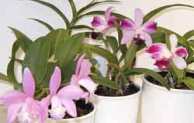 Hydroponic pots increase humidity when grouped together |
|||||
| 3. Grouping Plants
Together on
Humidity Trays (Very Good) Humidity Trays are light weight, plastic trays that display your plants on a grid that sits above a water reservoir. As the water in the tray evaporates, the humidity around your plants increases. Assembling your plants on Humidity Trays creates a micro-climate that increases humidity in two ways. First, moving your plants together naturally increases humidity. In addition, the water evaporating from the Humidity Tray gives your plants a real humidity boost. The Hydroponic Advantage with Humidity Trays: With traditional growing methods, Humidity Trays are hard to keep clean because they collect runoff water (and nutrients) that have passed through the plant from watering. Humidity Trays collects a multitude of chemicals from the water that has passed through the plants. In a sunny window, this water grows mold, algae, and a host of other things. Yuk!! Cleaning the tray becomes a weekly task. Our Hydroponic System Gives You the "Clean and Green Growing Environment" You're Looking For! With hydroponics, the plants sitting on the tray are growing in a "closed watering system". The outer pot holds the nutrient solution for the plant, and it's watertight. No water from the plant drains into the humidity tray. Chemicals from the plant never reach the water the tray, so keeping it clean is a breeze. The water in the tray is seperate from the water you use to water your plants. Simply add a drop or two of bleach (per gallon) to the water used in your Humidity Tray and you'll eliminate the mold and algae, (and other things) that usually grow there with traditional growing methods. Breathe easy - you're growing in a clean and green environment.
|
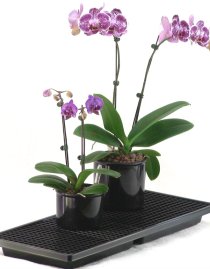 Grouping plants together on Humidity Trays increases humidity in 2 ways 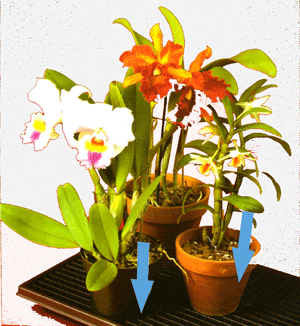 With traditional growing methods, humidity trays collect the water (with plant food) that passes through the grow pot. This water grows mold and algae when exposed to light. 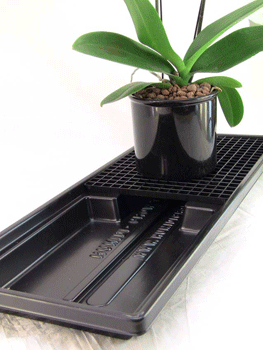 With Hydroponics everything stays clean because water (and nutrients) from the plants never reaches the tray. |
|||||
| 4. Turn Down the
Thermostat (Very Good) This is a big one!! And you'll save money! Humidity levels are closely tied to air temperature. To promote higher humidity during winter months, try turning down the thermostat a few degrees, especially at night. Both you and your plants will be healthier! Orchids embrace cooler temperatures instead of the hot, dry air from the furnace. Most orchids are content with evening temperatures as low as 50-55 degrees, So don't worry about your house being too cold. You'll be uncomfortable long before your plants will - even the "warm growers". Likewise, in the summer, orchids enjoy the natural, warm, humid air from the outside. Air-conditioners make us more comfortable by cooling the air and removing moisture. Orchids have a hard time tolerating cold air drafts from air-conditioning because the air has been robbed of its natural humidity. |
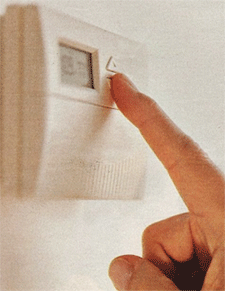 Lowering room temperatures at night during the winter has many advantages |
|||||
5. Invest in a Humidifier (Very Good) A room humdifier is also a very good solution to low humidity. Cost becomes a factor with this option however. An evaporative-pad humidifier is better than a mist humidifier, because, unlike a mist humidifier, it doesn't leave your orchids with a white film (from the minerals in the water being deposited on the leaves). Using humdity trays and a room humidifier and lowering the temperatures at night is by far the best solution to low humidity. And that's good news for both you and your orchids. |
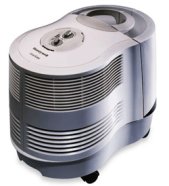 Room humdifiers are a good solution for dry air in your growing area. |
|||||
|
||||||
| Home | About Us | FAQ's | Contact
Us |
View Cart |
